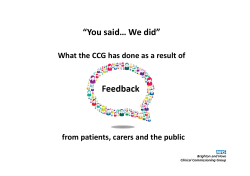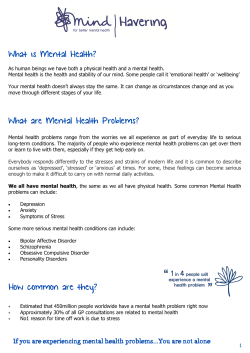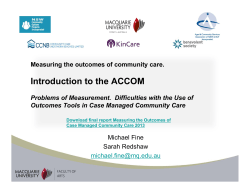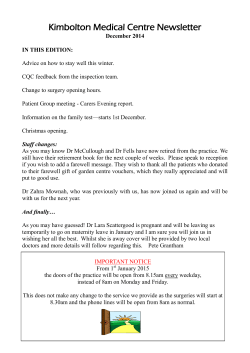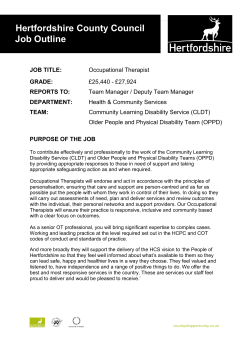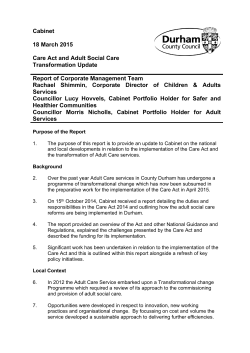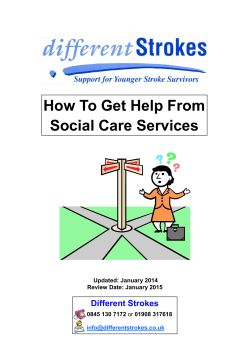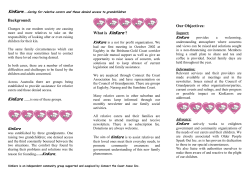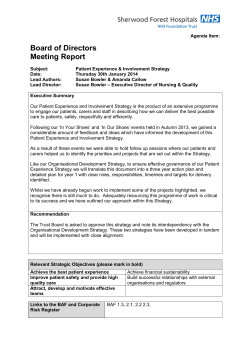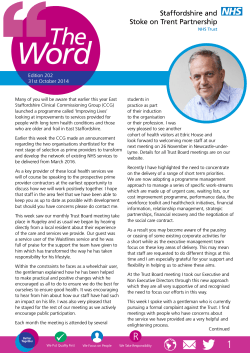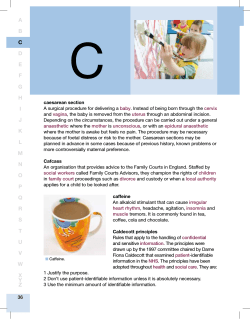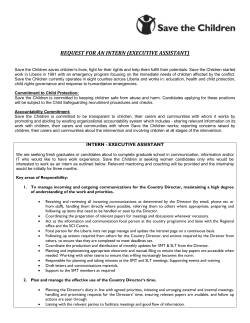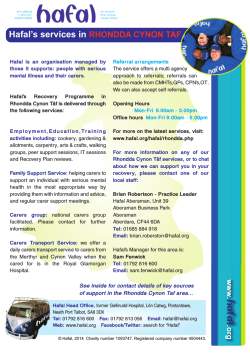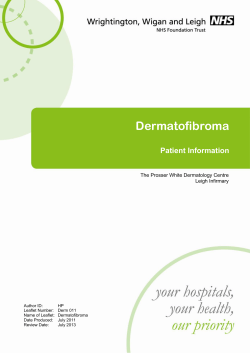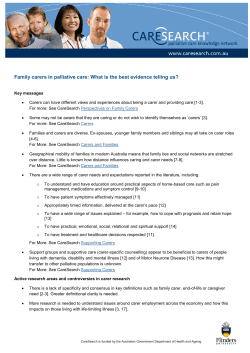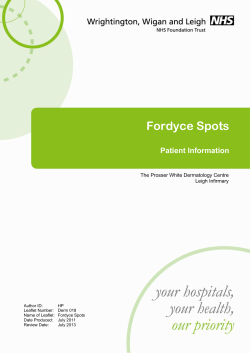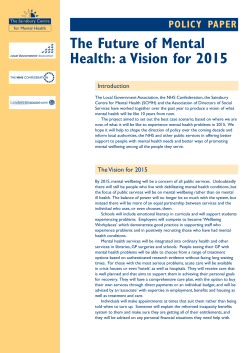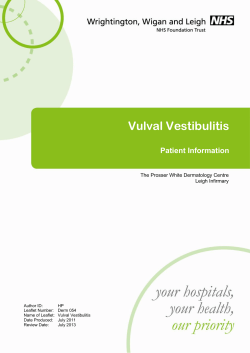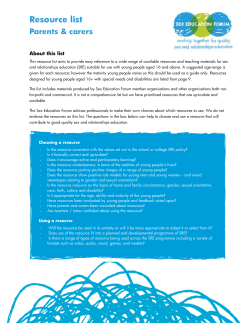
Annual Plan 2010 - 2011 Hertfordshire Partnership NHS Foundation Trust
Hertfordshire Partnership NHS Foundation Trust Annual Plan 2010 - 2011 Contents Introduction 2 Customers and Community 1. Easier access, less waiting, more choice 4 2. Continual improvement in quality and safety 6 3. Meeting the needs of individuals 8 4. Wellbeing and partnership 10 People 5. A skilled, flexible and motivated workforce 12 6. Innovation, accountability and leadership 14 Sustainability 1 7. Financial sustainability 16 8. A healthy environment 18 9. Summary Financial Statements 20 Glossary of Terms 21 Board and Executive Contact us 22 Introduction Our Vision “to be the leading provider of mental health and specialist learning disability services in the country.” Welcome to the 2010/11 annual plan for Hertfordshire Partnership NHS Foundation Trust (HPFT). This document sets out our priorities and objectives for the coming year. Each of our eight priority areas moves us further towards realising our vision to be the leading provider of mental health and specialist learning disability services in the country. At the heart of our vision is a commitment to providing excellent quality health and social care for the communities that we serve across Hertfordshire, Norfolk and North Essex. We aim to continually improve the services we provide to make a positive difference to the lives of service users and their carers, underpinned by the principles of involvement and independence. Our continuing partnership arrangements with the local authority provide an excellent opportunity to deliver a recovery orientated approach based on holistic assessment of both health and social care needs. In line with our strategy this year’s priorities are organised around three themes: Customers and Community, People, and Sustainability. They provide the foundations for the trust’s four year ‘Leading by Design’ programme which will transform: 1. the way we deliver our services, creating a model of care that meets the future needs and expectations of our service users and their carers; 2. the way we work, turning the trust into a more productive and flexible organisation; and 3. our care and work environments, ensuring they are fit for purpose in the 21st century. We have developed our plans alongside service users and carers, governors, staff and commissioners and will continue to engage with them as our plans evolve. We face difficult and challenging times ahead, but with the support of our staff and partners we will work to ensure that the trust remains a strong and sustainable organisation that provides the best quality services to our service users and their carers. Tom Cahill Chief Executive Annual Plan 2010 -2011 2 Customers and Community Our members take an active part in improving our services 3 1. Easier access, less waiting, more choice We will begin a four year programme transforming our service model and care environments to deliver higher quality services and a better experience for users and their carers. Why is this important? What will this mean? How will we deliver during 2010/11? To achieve our vision we need to do more than make incremental improvements to our current services and environments. Working with our service users, carers, staff and wider partners to redesign our services will ensure that we are able to best meet their future needs and expectations. It will also allow us to become a stronger, more productive and sustainable organisation in the face of the financial challenges facing the public sector. The service transformation strand of our ‘Leading by Design’ programme, will address four key areas. We will: 1. Develop a simpler, streamlined system of access into and from our services that will improve the experience of our service users, carers and referrers, and support more productive working 2. Establish core care pathways, to reduce unnecessary delays and ensure that for each individual the care provided is the most effective and appropriate 3. Align our community teams with the natural communities that exist across Hertfordshire in order to deliver more effective, efficient and locally sensitive services; and 4. Develop alternatives to traditional inpatient services, introducing a greater degree of choice and allowing service users with acute needs to remain connected to their community. We will also develop the best possible therapeutic environment for those service users who will continue to benefit from an inpatient stay. In 2010/11 we aim to put in place the foundations from which to build our programme of transformation over the next four years. We will: 1. Work with all our key stakeholders including service users, carers, staff, GPs and commissioners to develop preferred options for each of the four key areas above; 2. Trial alternatives to inpatient care including an acute day treatment unit, host family arrangements and 72 hour / crisis beds; and 3. Agree detailed plans for how our new model of care should be implemented over the following years. Beyond 2010/11 We will begin a phased programme implementing the agreed changes across all services from April 2011. The trust aims to have completed this programme by March 2014. Annual Plan 2010 -2011 4 Winning the building better health care award 2009 5 2. Continual improvements in quality and safety We will make in-year improvements to the quality and safety of our services and the links between individual services. Why is this important? What will this mean? How will we deliver during 2010/11? The delivery of high quality care including excellent treatment outcomes, positive service user experience and a safe environment is the cornerstone of our vision to be the leading provider. This means that we need to continue to deliver year on year improvements in quality alongside the implementation of our transformation programme. Our ‘Quality Account’ sets out three priority areas for 2010/11 which we know matter to our service users and carers. We will: In meeting the three objectives listed above. We will: 1. 1. 2. 3. Improve the safety of all inpatient service users; 2. Improve clinical effectiveness of care and treatment in line with recovery principles; and 3. Ensure service users and carers have the best possible experience through positive and therapeutic engagement. 4. Ensure 100% compliance with same sex accommodation standards; Reorganise our Crisis, Assessment and Treatment Teams (CATT) and roll out revised clinical risk management guidance and training; Remodel day services for adults to ensure the provision of up to date care in line with the intentions of our commissioners; and Roll out recovery-oriented care coordination training and ensure teams respond positively to local service user and carer feedback. Beyond 2010/11 Our priorities will be reviewed annually, with year on year adjustments to ensure our focus remains on the areas that are most important to our service users, carers and commissioners. Annual Plan 2010 -2011 6 The Intensive Outreach Team for Older People were highly commended at the Health Service Journal Awards 7 3. Meeting the needs of individuals We will work to deliver services that are tailored to individuals' needs, based on a commitment to equality and diversity. Why is this important? How will we deliver during 2010/11? Beyond 2010/11 We believe that leading services should be personalised and provide choice and independence. It is important that all trust processes and policies reflect this and that staff across the trust understand the equality and diversity dimensions of their role. We will: 1. Ensure staff behaviours reflect their equality and diversity responsibilities under the NHS Constitution and service users understand their individual rights and entitlements; Ensuring that services are tailored to individuals' needs is an ongoing process. We will continue to work with our service users and carers to ensure their views are reflected in the design of our services. We will also work towards the long term aim of ensuring that marginalised groups are more effectively engaged in community settings at an early stage. 2. Develop and roll out customer care and cultural competence training for inpatient staff to facilitate improved communication between staff and service users; and 3. Work with our service users and carers in redesigning our services as part of the trust’s ‘Leading By Design’ transformation programme. What will this mean? We will deliver a needs-led service through continuing to develop our focus on Recovery and taking forward the personalisation agenda. We will take account of the diverse population we serve and ensure our services are inclusive for all. Annual Plan 2010 -2011 8 Anti-Stigma campaign with hairdressers 9 4. Wellbeing and partnership We will work in partnership with local organisations to reduce stigma and improve mental health wellbeing. Why is this important? How will we deliver during 2010/11? Beyond 2010/11 We recognise that positive mental wellbeing begins at home and in the community. To realise the trust's vision we need to go beyond providing excellent care for the users of our services and become a leader on the wider mental health agenda within our communities. We will: 1 Develop an anti-stigma campaign in collaboration with Governors and Members; We aim to develop a wellbeing action plan outlining the way in which the trust will continue to develop and evolve its role in the community. We will become fully involved in Local Strategic Partnerships, working to develop new initiatives for reducing stigma and promoting wellbeing. 2 Work with the National Council for Palliative Care (NCPC), primary care and academic partners to develop an end of life pathway for people with dementia in line with the national dementia strategy; and 3 Develop new Mental Health Promotion and Suicide Prevention strategies in partnership with the Primary Care Trust (PCT), the Joint Commissioning Team (JCT) and the third sector. What will this mean? We will build on the strong links that we already have with local organisations and work with them to tackle stigma in our communities by increasing awareness and understanding of mental health problems. In addition we will promote mental wellbeing within our communities. Annual Plan 2010 -2011 10 People Staff receive their certificates of qualification at the staff award ceremony 11 5. A skilled, flexible and motivated workforce We will develop an engaged, motivated and supported workforce that has the skills, resources and flexibility to provide high quality care. Why is this important? How will we deliver during 2010/11? 6. Our staff are the key to the health and wellbeing of our community and the success of the trust. Motivated, engaged and appropriately skilled staff are essential to driving up quality and improving the experience of our service users. We will: 1. Complete a workforce capability and development plan to identify the skills, numbers and competence of professionals required for the next five years in light of the trust’s transformation programme; Promote equality and diversity in the workplace through revision of the trust’s harassment and bullying policy and processes, the roll out of mentoring programmes for BME staff, and completion of a gender pay audit; and 7. What will this mean? 2. Develop and begin to implement principles underpinning more flexible, effective and efficient ways of working e.g. through improved access to mobile technology. We will work to align the skills and resources available to our workforce with the requirements of our new service model and the need to work more productively. This will mean changes to roles and the way in which we all work. We will make these changes with our staff, listening to and taking account of their views. We will also provide the right working environments and training to ensure staff feel supported. Align our recruitment and retention strategy, our talent management strategy and our learning and development strategy to ensure that the appropriate skills are recruited, retained and developed to deliver and lead the workforce for the next five years; 3. Engage staff in the development of the trust’s plans and provide opportunity for feedback; 4. Improve our training environments by establishing an interim learning and development centre; 5. Develop and begin to implement a ‘Health and Wellbeing Strategy’ for staff; Beyond 2010/11 We will continue to develop and implement our workforce plans in line with the trust’s overall transformation programme. The trust aims to have completed this programme by March 2014. Staff engagement and open lines of communication will remain essential throughout this period. Annual Plan 2010 -2011 12 Staff engagement event 13 6. Innovation, accountability and leadership We will establish a culture that emphasises innovation, personal accountability and leadership across the organisation. Why is this important? How will we deliver during 2010/11? Beyond 2010/11 The trust needs to embrace new and modern approaches to providing care in order to become the leading provider. Delivering this change will require leadership from the board room through to the front line. Individuals need to be recognised and held to account for their contribution to realising the trust’s plans. We will: 1. Develop and roll out an accountability framework defining expected behaviours and actions across all staff groups and management disciplines; The above represents a significant cultural change that will continue beyond the next 12 months. Over the coming years we will continue to work to embed the trust’s values such that innovation, personal accountability and leadership are themes that inform our actions and behaviours. 2. Ensure all staff have an up to date personal development plan (PDP) and build completion of PDPs and appraisals into progression decisions; and What will this mean? 3. Develop our leadership programme to enhance staff skills and expertise, including a series of master classes and 360 degree appraisals for staff in leadership roles. We will establish a culture where staff across the organisation feel involved, able to contribute ideas and take responsibility for their part in delivering quality services. This will require clear communication of the trust’s objectives and plans, as well as the expectations placed on teams and individuals. As a result, every individual member of staff should be able to recognise their role in delivering the changes needed to realise the trust’s vision. Annual Plan 2010 -2011 14 Sustainability Looking after you now and in the future 15 7. Financial sustainability We will continue to ensure the financial sustainability of the trust by delivering efficiency savings and income growth. Why is this important? How will we deliver during 2010/11? Managing our income The financial health of the trust is fundamental to our ability to provide the highest quality care through reinvestment in our services and staff. We recognise that there are challenging times ahead and in order to ensure the financial sustainability of the organisation we will need to deliver both efficiency savings and income growth. During 2010/11 we will lay the foundations for our ‘Leading by Design’ transformation programme. This includes ensuring that it is planned and managed in a co-ordinated and robust way. Alongside delivering on the Leading by Design agenda we will focus on managing both our cost base and our income in order to secure the trust’s financial sustainability. This will be supported by the continued introduction of new service line management arrangements. We will: 1. Deliver on all key contractual targets in order to secure additional funding available through Commissioning for Quality and Innovation; 2. Develop the trust’s approach to Payment by Results for Mental Health in order to protect future income; and 3. Develop the trust’s market intelligence and approach to tendering to support new business and ensure that we grow the organisation in the most appropriate way. What will this mean? Managing our cost base Our plans to deliver quality services within a period of financial pressure will be realised through the ‘Leading by Design’ transformation programme. This means delivering services in new ways, realising efficiencies and reducing waste. In a competitive healthcare environment we must also ensure that we protect our existing services and identify appropriate opportunities for growth. We will: 1. Deliver savings of £6m as part of the trust’s cost improvement programme; 2. Develop productivity and efficiency measures for services and incorporate these in a performance management framework; and 3. Improve the use of information technology to support the delivery high quality care and more productive ways of working. Beyond 2010/11 We will need to remain diligent and robust in our approach to maintaining quality services in the face of less income from our commissioners. The trust’s Leading by Design programme provides us with the scope and flexibility to meet this challenge over the coming years. Annual Plan 2010 -2011 16 Trust staff take part in Bike Week June 2010 17 8. A healthy environment We believe that a sustainable future is not just about finances; we must also contribute towards a greener and healthier environment. Why is this important? How will we deliver during 2010/11? Beyond 2010/11 As a large community organisation we must recognise our role and responsibility in contributing towards a greener and more sustainable future. We have developed a carbon reduction programme that has received the highest rating possible by the Carbon Trust NHS Carbon Management Programme. During 2010/11 we will implement the first phase of this programme delivering a 10% reduction in carbon footprint across the trust. Our carbon reduction programme spans a three year period and will see a phased implementation across this time frame. Our final goal is to achieve a 25% reduction in our carbon footprint by March 2013. What will this mean? We will continue to work to better understand the impact the trust and its activities have on the environment. We will introduce different ways of working that reduce our carbon footprint e.g. reducing travel and looking at the way in which we use our estate. We will also actively promote and encourage environmental responsibility amongst all our staff. Annual Plan 2010 -2011 18 19 9. Summary Financial Statements The following tables summarise the income and expenditure and balance sheet for the Trust in the 2010/2011 planning period. Income and Expenditure Plan 2010-2011 Balance Sheet 2010/2011 £m £m Planned Income 212.1 Fixed Assets 141.9 Planned Expenditure 201.2 Current Assets 34.7 Current Liabilities 25.2 Operating Surplus 10.9 Depreciation Interest Receivable Financing Costs 3.6 0.1 4.0 Net Current Assets 9.5 Non-Current Assets 7.1 Planned Surplus 3.4 Non-Current Liabilities Total Assets Employed The above plan is a result of a prudent approach to both income and expenditure inflation assumptions, combined with a significant Cost Improvement Programme. Public Dividend Capital Income and Expenditure Reserve Revaluation Reserve Donation Reserve Total Funds Employed 16.1 142.4 79.4 15.0 47.6 0.4 142.4 Annual Plan 2010 -2011 20 Glossary of Terms Commissioning for Quality and Innovation (CQUIN) CQUIN is a payment framework which makes a proportion of providers' income conditional on quality and innovation. Its aim is to support the vision set out in High Quality Care for All of an NHS where quality is the organising principle. The framework was launched in April 2009 and helps ensure quality is part of the commissioner-provider discussion. Leading by Design NHS Constitution Our four year programme to deliver on the trust’s strategy. Tells patients, the public and our staff: From April 2010, all NHS organisations must produce a Quality Account: Annual Report for the public detailing the quality of services delivered. 21 What is important to the NHS – our principles and values The programme will: • Transform the quality of our services and environments • What people can expect from the NHS – their rights • Change how we work across the organisation • What we want to do – Our pledge • What we expect from patients, the public and staff – their responsibilities • Quality Account • Ensure the financial stability of the trust Board and Executive The responsibilities of the Board of Directors include managing the Trust on a day-to-day basis and planning for the organisation’s future. The Board consists of Executive Directors, who are usually full-time staff and have a permanent contract, and Non-Executive Directors, who are usually part-time and have a fixed term of office. Chair Hattie Llewelyn-Davies Chief Executive Tom Cahill Executive Directors Iain Eaves John Jones Dr Geraldine O’Sullivan Oliver Shanley Stanley Riseborough Non Executive Directors Bill Brown Manjeet Gill Carol Kennedy Filer Stephen Marsden Ruth Sawtell Colin Sheppard Herts County Council Assistant Director for Mental Health and Learning Disability Sue Darker Company Secretary Barbara Suggitt Contact us Your views and comments on our annual plan are important to us. If you have any comments please contact us at Trust Head Office, 99 Waverley Road, St Albans, Hertfordshire AL3 5TL Telephone: 01727 804629 Fax: 01727 804967 Annual Plan 2010 -2011 22 If you require this information in a different language or format please contact the Patient Advice and Liaison Service: Tel: 01727 804629, Fax: 01727 804967 W razie potrzeby powyższy tekst można otrzymać w innymformacie lub innym języku. Informacji w tej sprawie udziela: Patient Advice & Liaison Service: Tel: 01727 804629, Fax: 01727 804967 (Polish) Se avete bisogno di queste informazioni in una lingua o in unformato differente, vi preghiamo di contattare: Patient Advice & Liaison Service (Servizio relazioni e consigli per i pazienti) Tel: 01727 804629, Fax: 01727 804967. (Italian) 01727 804629 01727 804629 01727 804967 01727 804967 Hertfordshire Partnership NHS Foundation Trust works toward eliminating all forms of discrimination and promoting equality of opportunity for all www.hertspartsft.nhs.uk Date of publication July 2010
© Copyright 2025
